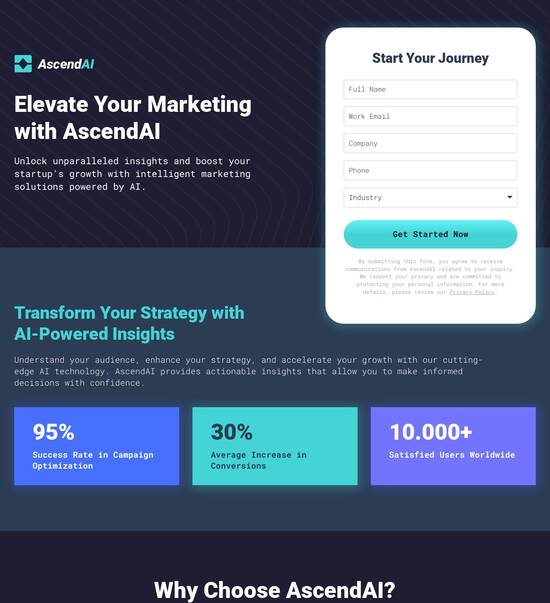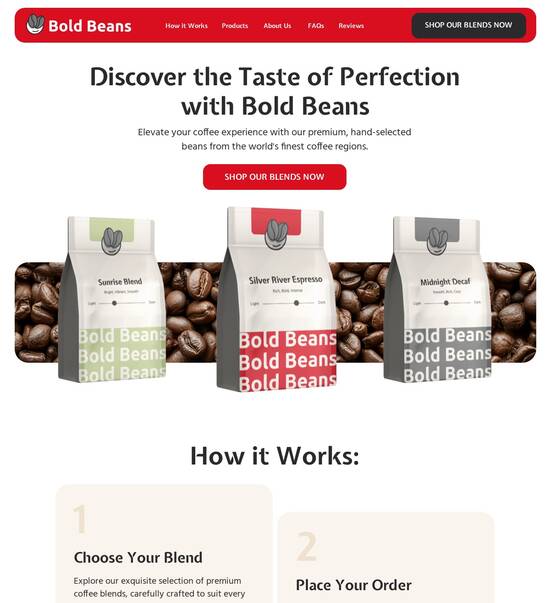
Next.js optimized affiliate program page template
Explore Similar TemplatesAbout template
Supercharge your affiliate program page with Next.js for outstanding performance! Learn more today.
Recommended templates

Easy to build without coding
With the intuitive drag-and-drop builder, anyone on your team can create high-converting pages without any knowledge of code or design. Make enhancements to your landing page with custom widgets using Javascript, HTML/CSS, or third-party scripts.

Multiple layouts for any industry and goal
Select from 500+ landing page layouts built to boost conversions across industry-specific scenarios. Customize them by adjusting fonts, adding images, and generating on-brand content with the AI assistant. Quickly scale with Instablocks® and Global Blocks that you can save, reuse, and update globally.

Loads fast and looks polished on any device
Every template is responsive, which means they present professionally on any device and load blazingly fast with our Thor Render Engine. You can also power them up with Google AMP technology to deliver an unparalleled mobile experience and drive higher conversions.

Robust analytics & experimentation
Get real-time updates and reporting across all your devices, showing the number of visitors, conversions, cost-per-visitor, and cost-per-lead. Launch AI-powered experiments, run A/B tests, and use heatmaps to analyze user behavior, then optimize your landing page to maximize conversions.







Easy to build without coding
With the intuitive drag-and-drop builder, anyone on your team can create high-converting pages without any knowledge of code or design. Make enhancements to your landing page with custom widgets using Javascript, HTML/CSS, or third-party scripts.
Multiple layouts for any industry and goal
Select from 500+ landing page layouts built to boost conversions across industry-specific scenarios. Customize them by adjusting fonts, adding images, and generating on-brand content with the AI assistant. Quickly scale with Instablocks® and Global Blocks that you can save, reuse, and update globally.
Loads fast and looks polished on any device
Every template is responsive, which means they present professionally on any device and load blazingly fast with our Thor Render Engine.
Robust analytics & experimentation
Get real-time updates and reporting across all your devices, showing the number of visitors, conversions, cost-per-visitor, and cost-per-lead. Launch AI-powered experiments, run A/B tests, and use heatmaps to analyze user behavior, then optimize your landing page to maximize conversions.
All the features you need to build nextjs hero section template
Explore more featuresLearn how to build top-performing landing pages for any goal
FAQs
Leading the way in building high-performing landing pages





The ultimate guide to using Instapage for landing page optimization
Creating high-converting landing pages is essential for maximizing ROI in your digital marketing campaigns. Instapage offers an intuitive platform to design and optimize landing pages that not only look great but also drive results. In this guide, you will learn the step-by-step process for using Instapage effectively, ensuring your strategies are optimized to capture leads and boost conversions.
Understanding the importance of landing pages
Landing pages serve as critical touchpoints in the customer journey, designed specifically to convert visitors into leads or customers. They eliminate distractions and focus the user's attention on a single call-to-action, whether that's signing up for a newsletter, making a purchase, or filling out a form. Understanding this value is crucial for marketers in sectors like education and tech/SaaS.
- Highly focused content: Landing pages highlight specific offers to induce action.
- Increased conversion rates: Targeted messaging leads to higher engagement.
- Tracking capabilities: Analytics allow for performance measurement and optimization.
Step 1: Choose from over 100 high-converting templates
Instapage provides a vast library of ready-to-use templates suited for various industries, including business services and government. Start by selecting a design that resonates with your campaign goals and aligns with your brand identity, enabling a seamless experience for your audience.
Step 2: Customize your landing page with intuitive builders
Personalizing your landing page ensures that it speaks directly to your target audience. Use Instapage’s drag-and-drop functionality to customize text, images, and layouts. Tools like dynamic text replacement help tailor content to specific visitor segments, enhancing user engagement.
- Use Instablocks: These reusable sections can save time and maintain consistency across pages.
- Edit in real-time: Instant feedback features allow for quick modifications during collaboration.
- Optimize images: Ensure fast load times by maintaining optimized image sizes at all times.
Step 3: Optimize your pages for conversions
Utilize built-in A/B testing and heatmaps to analyze visitor behavior on your landing page. Assess which elements perform best, refining your approach to maximize conversions. This data-driven strategy aligns perfectly with the objectives of modern marketers in various fields.
- Conduct A/B tests on headlines: Test different headlines to see which captures more leads.
- Utilize heatmaps: Understand where users are clicking to refine your layout.
- Analyze performance metrics: Dive into conversion rates to assess overall effectiveness.
Following these steps ensures your landing pages are designed with a focus on maximizing ROI while meeting the needs of diverse audiences.
Ready to elevate your landing page game? Start using Instapage today and transform how you engage with your digital audience.
People also ask about Next.js optimized affiliate program page template
Next.js optimized affiliate program page template
Understanding the landscape of affiliate programs and landing pages
When considering the significance of optimizing affiliate program pages for conversion, it's imperative to recognize that these are often the first touchpoints potential customers encounter. A well-structured affiliate page not only informs and educates visitors about the offerings but also drives conversions through compelling calls to action and engaging content. An optimized page can drastically increase the chances of converting traffic into actual sales or leads.
The trend of affiliate marketing is on the rise, reflecting a growing channel for generating income. This shift has a major impact on website traffic as businesses increasingly rely on affiliate partnerships to drive brand awareness and sales. According to recent statistics, affiliate marketing accounts for more than 16% of all online orders, indicating its influence and making it crucial for marketers to refine their strategies.
Key components of effective landing pages must accommodate both web developers and marketers' needs. Marketers seek high-converting designs that provide clear information and compelling offers, while developers look for clean, maintainable code that is easy to integrate and scale. Balancing these requirements will enhance the overall effectiveness of affiliate program pages.
The rise of Next.js in web development
Next.js has emerged as a popular framework in the web development landscape, primarily due to its elegant combination of features that make building applications fast and efficient. As a React-based framework, it offers capabilities such as server-side rendering (SSR) and static site generation (SSG), enabling developers to create compelling applications that cater to various use cases. These functionalities not only enhance performance but also improve SEO rankings, contributing to better visibility in search engines.
Among the many advantages of using Next.js for scalable web applications lies its simplicity and flexibility. It allows for dynamic page routing and easy integration with various data sources, paving the way for personalized content delivery. Furthermore, developers can utilize Next.js' advanced features to deploy applications effortlessly to platforms such as Vercel or Netlify, reducing deployment time and complexity.
Next.js aligns seamlessly with modern development trends. With a focus on performance and user experience, it supports both SSR and SSG out of the box, enabling developers to choose the right rendering method based on their needs. This adaptability empowers teams to build faster websites that improve engagement and conversion rates, a crucial aspect for any affiliate marketing strategy.
The best Next.js features for affiliate program pages
One of the standout features of Next.js is its seamless routing capability, which allows developers to create dynamic page generation effortlessly. This functionality is particularly beneficial for affiliate marketing, as it enables personalized content delivery based on user behavior and preferences. For instance, a user clicking through from a specific ad campaign can be directed to a tailored landing page that speaks directly to their interests, increasing the likelihood of conversion.
Another significant advantage is the built-in API routes that expand capabilities without adding unnecessary complexity. This feature allows developers to create serverless functions directly within their Next.js applications, enabling the handling of form submissions, data fetching, or third-party API interactions seamlessly. By eliminating the need for additional backend frameworks, Next.js keeps the development process streamlined.
Image optimization is another critical feature that enhances page speed, which is essential for user experience and SEO. Next.js provides automatic image optimization, ensuring that images are served in the most suitable format and size. This not only improves loading times but also keeps users engaged on the page, further driving conversion opportunities.
Leveraging Tailwind CSS for Next.js affiliate program pages
Tailwind CSS is a utility-first CSS framework designed to provide flexibility and ease of use when styling applications. By combining Tailwind CSS with Next.js, developers can craft aesthetically pleasing landing pages that are both responsive and performant. This integration enhances the development process, allowing for rapid prototyping and iteration while maintaining a clean codebase.
The benefits of this combination extend to creating high-performing content geared towards various audiences. With Tailwind’s utility classes, developers can quickly adjust styles based on real-time feedback and end-user interactions, ensuring that the designs remain aligned with user preferences. This customization ultimately contributes to a better user experience, essential for keeping potential customers engaged.
Integrating Tailwind CSS into a Next.js project is straightforward. Developers can start by installing Tailwind via npm and then configure it within their Next.js setup. This can be done through the following steps: 1. Install Tailwind CSS: Run `npm install tailwindcss` and generate the configuration files. 2. Include Tailwind in your CSS by importing it into your global stylesheet. 3. Customize your theme or add any necessary plugins. 4. Start building your components using utility classes.
Crafting an optimized Next.js affiliate page template
To define a well-structured affiliate page, you need to focus on essential layout components, including headers, calls to action (CTAs), and content sections. Starting with the top navigation ensures user access to key areas quickly. A streamlined navigation experience prevents potential customers from feeling lost and helps them find relevant sections without hassle.
Hero sections play a vital role in engaging visitors. They serve as the first visual encounter a visitor has with your page, so it’s crucial to incorporate compelling visuals and messaging that clearly communicate the value proposition. Effective hero sections capture interest at first glance, making visitors more likely to engage with the content that follows.
Incorporating social proof, such as testimonials and case studies within your affiliate program page, builds trust and helps alleviate any concerns potential customers may have. Real feedback from satisfied customers can significantly influence decision-making, often leading to higher conversion rates.
Including a responsive design strategy is paramount to ensure that the page caters to all devices. A significant portion of web traffic comes from mobile devices, so optimizing the design for mobile use increases accessibility and user satisfaction. Finally, utilizing dynamic components helps keep the content fresh and interactive. Real-time updates can engage visitors further, encouraging them to learn more about your affiliate offers.
Key elements to include in your Next.js template
Analytics integration: Use analytics tools to track user behavior and optimize page performance based on collected data.
SEO best practices: Enhance visibility by including metadata, alt tags, and structured data within your pages.
A/B testing capabilities: Leverage both Next.js and external tools to identify the most effective design and content combinations.
Content management systems (CMS) compatibility: Ensure your template works with popular CMS options like Contentful, Sanity, or Strapi for easy updates.
Performance optimization strategies: Implement code splitting and lazy loading for images and components to enhance loading times.
Accessibility considerations: Focus on inclusive design practices to ensure all users can navigate and interact with your page seamlessly.
Security practices: Incorporate security measures to ensure safe transactions and protect user data throughout the site.
Case studies: Successful implementations of Next.js in affiliate marketing
Examining real-world examples provides insights into how businesses successfully engage customers through optimized Next.js affiliate program pages. For instance, some companies experienced significant increases in sales after migrating their affiliate pages to Next.js, leveraging its performance benefits and improved loading times. These transitions often result in lower bounce rates and higher average time spent on site, two vital metrics for conversion.
In one notable case, a tech company saw its conversion rates rise by over 30% after the implementation of a Next.js template. This achievement was largely due to the refined user experience and speed enhancements that enabled quicker access to product information. Another example involved an educational platform that utilized Next.js to create personalized landing pages, resulting in user engagement metrics significantly surpassing previous benchmarks.
Insights from the developer community
The developer community is profoundly influenced by Next.js, as many professionals share their experiences and insights on how to harness the framework's potential for affiliate marketing projects. Interviews with various web developers underline the practical applications of Next.js, detailing unique customizations they implemented and the corresponding impacts on conversion rates.
Several developers emphasize the importance of staying updated with Next.js features. For example, leveraging the latest releases and capabilities, such as new image optimization techniques, can lead to better performance and user satisfaction. Sharing best practices and customization strategies among the community further enhances the overall effectiveness of using Next.js for affiliate program pages.
Future trends in affiliate program pages and Next.js development
Looking ahead, the landscape for affiliate program pages is set to evolve significantly, influenced by technological advancements and shifts in user expectations. Future developments in design and technology for landing pages will likely focus more on personalization and enhanced user experiences, necessitating adaptability and innovation from businesses.
The evolving role of AI and automation in optimizing affiliate marketing strategies indicates a future where machine learning algorithms can tailor experiences based on user behavior and preferences. Next.js is well-positioned to adapt to these trends, remaining relevant as it embraces these technological advancements.
As the expectations of web applications grow, the Next.js framework will continue to evolve, providing developers with the tools to create optimized and high-performing affiliate program pages that meet future demands.
Embarking on your Next.js affiliate page journey
Starting your journey towards launching an optimized Next.js affiliate page can seem daunting, but breaking it down into manageable steps simplifies the process. Begin by setting up your Next.js environment and configuring project settings tailored to your affiliate program needs. This includes planning the layout and structure of your page as well as identifying key performance indicators you will track.
You’ll want to utilize the best practices we've outlined, such as ensuring analytics integration and responsive design. It’s also essential to continually learn and adapt, leveraging community resources and staying connected with the latest updates and developments in the Next.js ecosystem. By doing so, you'll be well-equipped to create a powerful landing page that meets both your marketing and user experience objectives.
Ready to skyrocket conversions?
Supercharge your ad campaigns with high-performing landing pages
Get started














